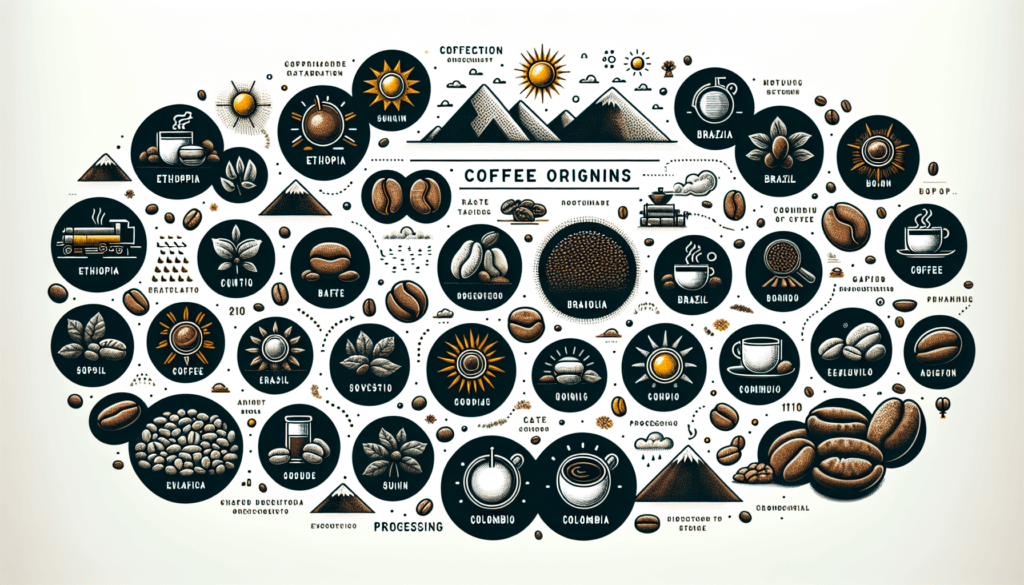If you’re a coffee enthusiast looking to broaden your understanding of different coffee origins and flavors, you’ve come to the right place. In this article, we will take you on a delightful journey through the diverse world of coffee, from its origins in various regions to the unique flavors that each origin brings. Whether you prefer a rich and bold cup or a delicate and nuanced brew, this guide will equip you with the knowledge to navigate the vast array of coffee options available and enhance your coffee experience to new heights. So grab your favorite mug, sit back, and prepare to embark on a flavor-filled adventure.

Understanding Coffee Origins
Coffee is one of the most widely consumed beverages in the world, but have you ever stopped to think about where your coffee comes from? Understanding the origins of coffee is key to unlocking a world of flavors and discovering the unique characteristics that each region has to offer. From the factors that influence coffee flavor to the different roasting styles for different origins, let’s dive into the fascinating world of coffee origins and learn how each one contributes to the overall taste and experience of your cup of joe.
Factors that Influence Coffee Flavor
Coffee flavor is influenced by a multitude of factors, including the soil, climate, altitude, rainfall, and even the processing method. These factors play a significant role in shaping the flavor profile of the coffee beans. For example, coffee beans grown in high altitude regions often have a more acidic and floral flavor, while those grown in lower altitude regions tend to have a fuller body and heavier mouthfeel. Similarly, the amount of rainfall a region receives can affect the sweetness and acidity of the coffee beans.
Arabica vs. Robusta Beans
When it comes to coffee beans, there are two primary species that dominate the market: Arabica and Robusta. Arabica beans are known for their delicate and nuanced flavors, with notes of fruit, chocolate, and nuts. They are typically grown at higher altitudes and require specific growing conditions. On the other hand, Robusta beans have a stronger and more bitter taste, with higher caffeine content. They are often used in espresso blends for their ability to provide a rich crema and a strong, full-bodied flavor.
Single-Origin vs. Blended Coffees
Single-origin coffees are sourced from a specific region or farm and are prized for their unique flavors and characteristics. These coffees allow you to experience the distinct terroir of a particular origin, showcasing the nuances and complexities that can only be found in that specific microclimate. On the other hand, blended coffees are a combination of beans from multiple origins. Blends are often created to achieve a specific taste profile, balancing flavors and creating a well-rounded cup of coffee.
Common Coffee Growing Regions
Coffee is grown in a variety of regions around the world, each with its own distinctive flavor profile. Some of the most well-known coffee growing regions include Latin America, Africa, Asia-Pacific, and Central America. Latin American coffees are known for their bright acidity, medium body, and balanced flavors. African coffees are prized for their fruity and floral notes, with a wine-like acidity. Asian-Pacific coffees often have earthy and spicy flavors, while Central American coffees tend to have a nutty and chocolatey profile.
Flavor Profiles of Coffee Origins
Latin America
Latin American coffees encompass a wide range of flavors, from the bright and citrusy coffees of Costa Rica to the nutty and chocolatey coffees of Brazil. Colombian coffees, with their medium body and balanced acidity, are among the most renowned in the world. These coffees often have caramel, chocolate, and nutty undertones, making them a favorite among coffee lovers. Mexican coffees, on the other hand, are known for their light acidity and delicate flavor profiles, with hints of fruity sweetness.
Africa
African coffees are known for their unique and complex flavor profiles. Ethiopian coffees, in particular, are highly regarded for their bright acidity and floral, fruity notes. The famous Yirgacheffe coffee from Ethiopia is often praised for its jasmine-like fragrance and distinct citrus flavors. Kenyan coffees, on the other hand, tend to be more acidic and have a bold and wine-like taste. They often exhibit flavors of berry, black currant, and sometimes even tomato.
Asia-Pacific
Asia-Pacific coffees offer a wide range of flavors, from the earthy and spicy coffees of Sumatra to the clean and bright coffees of Papua New Guinea. Indonesian coffees, such as those from Sumatra and Java, are known for their low acidity and rich, full-bodied flavors. These coffees often have herbal and earthy undertones, with hints of tobacco and dark chocolate. On the other hand, coffees from Papua New Guinea and the Philippines are known for their brightness and clean, citrusy flavors.
Central America
Central American coffees, including those from Guatemala, Honduras, and Costa Rica, are known for their balanced and flavorful profiles. Guatemalan coffees, in particular, are highly prized for their bright acidity, medium body, and complex flavors. These coffees often exhibit notes of chocolate, caramel, and stone fruit, with a pleasant acidity that cuts through the richness. Honduran coffees, on the other hand, are known for their sweetness and slight nuttiness, while Costa Rican coffees offer a clean and vibrant cup with flavors of citrus and tropical fruit.
Different Roasting Styles for Different Origins
Roasting plays a crucial role in unlocking the flavors of coffee beans. Different origins require different roasting styles to highlight their unique characteristics. For example, light roast profiles are often used for African coffees to preserve their delicate flavors and bright acidity. Medium roasts bring out the balanced flavors of Latin American coffees, allowing the sweetness and nuttiness to shine through. Dark roasts, on the other hand, are commonly used for Asian-Pacific coffees to enhance their earthy and spicy flavors.

The Role of Altitude in Coffee Flavor
Altitude is a crucial factor that influences the flavor profile of coffee beans. As a general rule, higher altitude coffee tends to have a more complex and nuanced flavor profile. The cooler temperatures at higher altitudes slow down the maturation process of the coffee cherries, allowing them to develop more sugars and aromatic compounds. This results in a more acidic and flavorful cup of coffee. Additionally, the higher altitude often translates to a denser bean, which contributes to a fuller body and a richer mouthfeel.
Processing Methods and Flavor
The processing method used after the coffee cherries are harvested also has a significant impact on the final flavor of the beans. There are three main processing methods: washed, natural, and honey process. Washed coffees tend to have a cleaner and brighter flavor profile, with more acidity and fruitiness. Natural coffees, on the other hand, have a heavier body and a more pronounced sweetness, with flavors reminiscent of dried fruit. Honey processed coffees fall somewhere in between, offering a balance of sweetness, acidity, and body.

Fair Trade and Organic Coffee
If you’re passionate about sustainability and ethical practices, you may be interested in exploring fair trade and organic coffees. Fair trade coffee ensures that farmers receive fair compensation for their hard work and have access to better living conditions. It also promotes environmental sustainability by encouraging responsible farming practices. Organic coffee goes a step further by ensuring that no synthetic chemicals are used in the cultivation and processing of the coffee beans. These coffees are often certified by various organizations to guarantee their organic status.
Cupping: Evaluating Coffee Flavors
Cupping is a method used by professionals to evaluate the flavors, aromas, and overall quality of coffee beans. It involves tasting small samples of coffee brewed with precise measurements and parameters. During cupping, coffee tasters assess the coffee’s acidity, sweetness, body, and other characteristics. This practice allows them to identify any defects or off-flavors and gives them a better understanding of the coffee’s flavor profile. Cupping sessions can be a fun and educational way for coffee enthusiasts to explore different origins and flavors.

Tips for Exploring Coffee Origins and Flavors
If you’re eager to explore the world of coffee origins and flavors, here are some tips to get you started:
Try Different Brew Methods
Experimenting with different brew methods can help you uncover the unique flavors of each coffee origin. Whether you prefer pour-over, French press, or espresso, each method can bring out different characteristics in the beans. Play around with grind size, brewing time, and water temperature to discover the brewing method that best accentuates the flavors you enjoy.
Visit Local Coffee Shops and Roasters
Local coffee shops and roasters are a great resource for exploring different coffee origins. They often offer a variety of single-origin coffees and can guide you through the tasting experience. Take the opportunity to talk to the baristas and roasters, who are usually knowledgeable about the flavor profiles of their beans. They may even host cupping events or coffee tasting sessions that allow you to sample different coffees side by side.
Keep a Tasting Journal
Keeping a tasting journal can help you track your coffee discoveries and remember your favorite flavors. Note down the origin, roast level, and flavor profile of each coffee you try. Pay attention to the specific flavors you detect, such as fruity, chocolatey, or nutty notes. This will not only help you develop your palate but also enable you to compare different origins and find your preferred flavor profiles.
Experiment with Flavor Pairings
Coffee is a versatile beverage that can be paired with a wide range of foods. Experiment with different flavor pairings to enhance your coffee tasting experience. For example, try pairing a citrusy African coffee with a piece of dark chocolate or a nutty Latin American coffee with a buttery pastry. The combination of flavors can elevate the overall taste and create a harmonious sensory experience.
Conclusion
Understanding coffee origins is a fascinating journey that can greatly enhance your appreciation for this beloved beverage. From the factors that influence coffee flavor to the different processing methods and roasting styles, each element contributes to the complex world of coffee flavors. By exploring the diverse origins and experimenting with different brew methods, you can unlock a kaleidoscope of flavors and embark on your own coffee tasting adventure. So, the next time you take a sip of your favorite cup of coffee, take a moment to appreciate the origins and flavors that make it truly unique.



